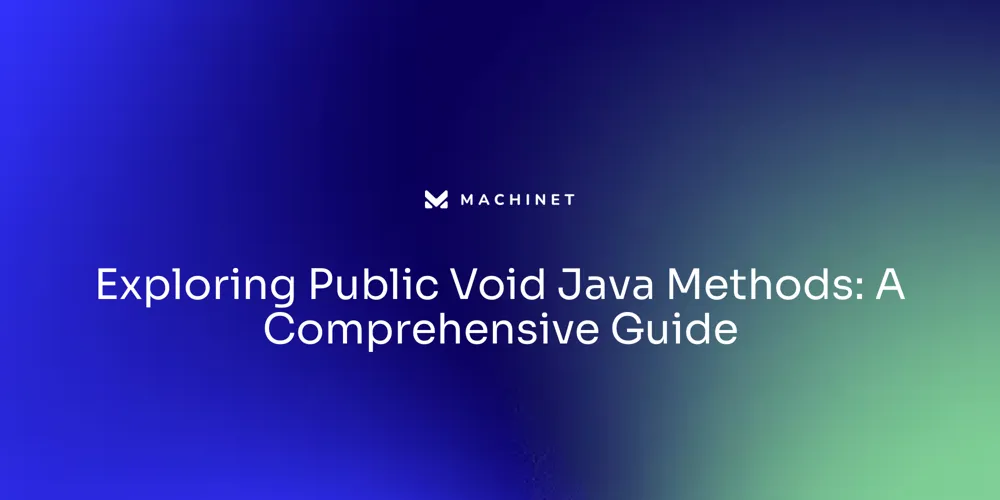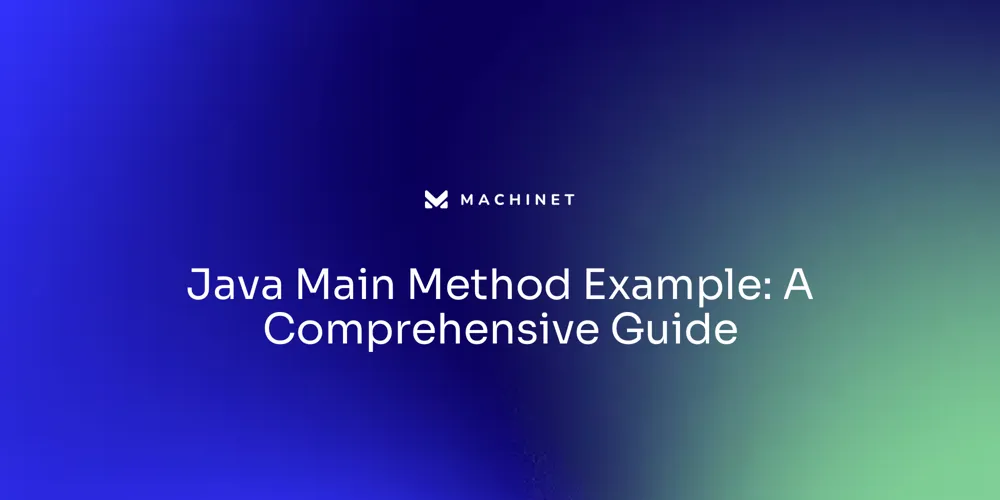
Table of Contents
- What are Public Void Java Methods?
- Understanding the Syntax of Public Void Java Methods
- The Role of Public Access Modifier in Java Methods
- The Significance of Void in Java Methods
Introduction
In Java programming, methods play a crucial role in executing tasks and building routines. One type of method is the "public void" method, which is known for its ability to perform actions without returning any value. This type of method is particularly useful for performing actions rather than calculations.
In this article, we will explore the syntax, purpose, and significance of public void Java methods. We will also discuss the role of the public access modifier in Java methods and the importance of clean and structured coding practices. Join us as we delve into the world of public void Java methods and discover their importance in modern software development.
What are Public Void Java Methods?
In Java, methods are essential constructs within a class, acting as the building blocks for programming routines. A method in Java is defined by its signature, which includes an access specifier, a return type, and, optionally, parameters.
The access specifier, such as 'public', determines the method's visibility across different classes. A 'void' return type signifies that a method does not return any value after execution, making it useful for performing actions rather than calculations.
The structure of a Java method is as follows:
public void methodName(parameterType parameterName) { // Method body: statements that perform the task }
This syntax illustrates the method's accessibility, purpose, and the inputs it requires to operate. The benefits of such clear and structured coding practices include enhanced readability, which facilitates quicker understanding and collaboration among developers, and a decreased likelihood of introducing bugs during code modifications.
Recent updates to Java, like in Java 21, reflect an ongoing effort to streamline the language for both beginners and seasoned programmers. The elimination of the requirement for the 'public static void main()' method is a step towards embracing a more modular and functional programming approach.
Simplifying Java's syntax aligns with the principles of clean code, which emphasizes writing code that is not only error-free but also expressive and easy to maintain. As software continues to evolve, these principles are vital for adapting to new requirements and fixing issues with minimal effort. Statistics reveal the practical side of these coding practices. For instance, 91% of Java applications use logging frameworks to troubleshoot issues, indicating the importance of clarity and structure in code for maintenance and debugging. Among these, Log4j is the most popular, used by 76% of applications, followed by JBoss Logging and Logback. These tools reflect the industry's commitment to clean code and the tangible benefits it brings to Java development.
Understanding the Syntax of Public Void Java Methods
Delving into Java methods, one encounters the essential blueprint for crafting a public void method. This structure is a cornerstone for writing expressive and maintainable Java code. A public void method is defined by its unique syntax as follows:
java
public void methodName() {
// Code to be executed
}
In this syntax, 'public' specifies the method's accessibility across different classes, while 'void' indicates the absence of a return value, signifying that the execution of this method yields no direct output.
The 'methodName' is a descriptor adhering to Java's naming conventions, encapsulating the method's purpose. Methods in Java are not only about executing tasks but also about enhancing code readability and reusability. They are the named blocks of code, each designed to perform a distinct function, and can be categorized as predefined or user-defined.
Predefined methods, like System.out.println() for output and Math.max() for calculations, come built-in with Java. User-defined methods, on the other hand, are custom-designed by developers to fulfill specific programmatic needs. The recent advancements in Java 20, such as virtual threads and the Vector API, further illustrate the language's evolution towards more concise and powerful code expressions.
These features augment the developer's toolkit, enabling more efficient handling of concurrent operations and vector computations. As we strive for clarity and efficiency in Java programming, it's paramount to remember that clean Java code is not just about being error-free. It is about crafting code that is intuitive, well-structured, and communicates its intent lucidly, thus fostering maintainability and effective collaboration among developers.

The Role of Public Access Modifier in Java Methods
Java's 'public' access modifier serves as the gatekeeper for method accessibility, allowing methods to be invoked from any class, anywhere in the code landscape. This not only ensures that methods can be reused across different classes, enhancing the modularity of code, but also fosters efficient interclass communication. For instance, public methods provide a streamlined way of extracting data and performing operations on complex data structures, as seen in the use of pattern matching, a feature that matches values against a pattern with variables and conditions for more intelligible code.
However, the use of public methods comes with considerations of security and proper management. A research study indicated that over 18% of dependencies in Maven-based technologies could be hijacked, posing a threat to projects using public libraries. This highlights the importance of careful use of access modifiers and adherence to best practices in naming and structuring code to avoid vulnerabilities.
Adopting naming conventions like camelCase for methods and avoiding generic names like 'data' or 'temp' are recommended to maintain clarity. Additionally, verbs are preferred for method names indicating actions, such as 'calculateTotalPrice()', while nouns are used for variables, like 'totalPrice'. This clarity in naming and access control is crucial in a language that has matured significantly since its inception nearly 30 years ago, with Oracle's continuous updates ensuring Java remains a robust foundation for modern software development.
The Significance of Void in Java Methods
In Java, methods defined with the 'void' keyword are essential for carrying out specific operations without returning any value to the caller. The void methods are integral to Java programming, as they allow developers to execute tasks that don't require output but are crucial for the functioning of the application.
For instance, the iconic 'main()' method in Java, which is the entry point of any Java application, is a void method. It's declared as 'public static void main(String[] args)', indicating that it performs actions but does not return any data.
Recent developments in Java, such as the introduction of Pattern Matching and Sealed Classes, further demonstrate the language's commitment to concise and readable code. Pattern Matching, for instance, enables developers to match values against specific patterns, simplifying the extraction and manipulation of data from complex structures.
Moreover, the evolving Java ecosystem, evidenced by the Vector API and enhancements to the Stream API in JDK 17 and the introduction of new features in Java 20, reflects a continuous effort to improve code expressiveness and efficiency. The transition away from the requirement of the 'public static void main()' method in Java 21 aligns with the language's progression towards simplicity and consistency with other programming languages. This shift underscores Java's evolving nature, catering to both seasoned developers and newcomers striving to grasp its syntax and semantics. Such changes are part of Java's broader goal to enhance developer productivity and code maintainability, ensuring that Java code is not only functional but also a pleasure to write and read.
Conclusion
In conclusion, public void Java methods are essential building blocks for programming routines. They allow developers to perform actions without returning any value, making them particularly useful for tasks that don't involve calculations. The syntax of public void methods is clear and structured, enhancing code readability and facilitating collaboration among developers.
The public access modifier in Java methods plays a crucial role in determining the method's visibility across different classes. It allows methods to be invoked from any class, promoting code reusability and efficient interclass communication. However, it is important to use access modifiers carefully and adhere to best practices in naming and structuring code to ensure security and avoid vulnerabilities.
The significance of the void keyword in Java methods lies in its ability to execute specific operations without returning any value. Void methods are integral to Java programming, enabling developers to carry out tasks that are crucial for the functioning of the application. Recent developments in Java, such as Pattern Matching and Sealed Classes, reflect the language's commitment to concise and readable code.
Overall, public void Java methods contribute to clean and structured coding practices, enhancing code maintainability and facilitating efficient software development. As the Java ecosystem continues to evolve, these methods play a vital role in adapting to new requirements and improving developer productivity. Embracing these principles ensures that Java code is not only functional but also expressive and easy to maintain.
AI agent for developers
Boost your productivity with Mate. Easily connect your project, generate code, and debug smarter - all powered by AI.
Do you want to solve problems like this faster? Download Mate for free now.




